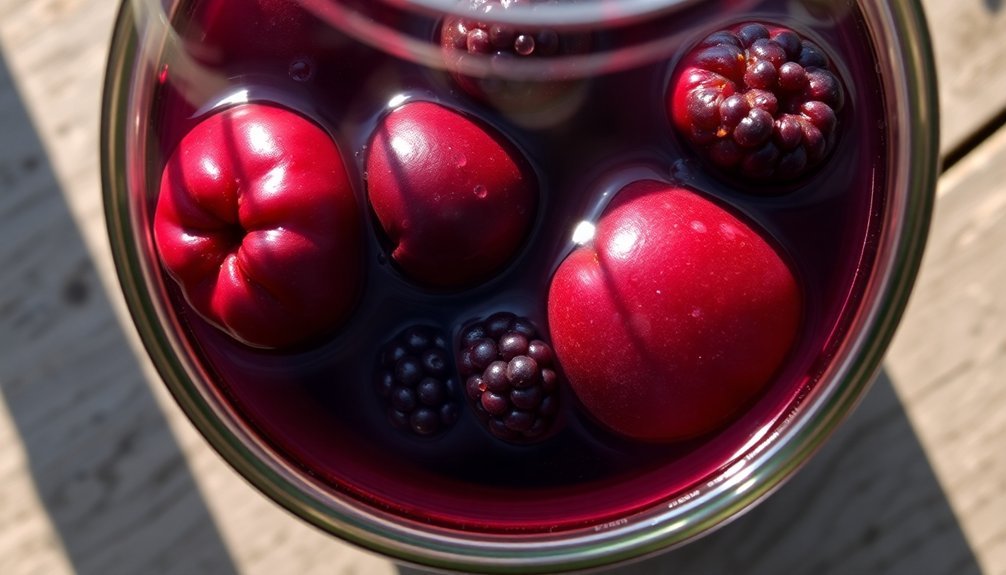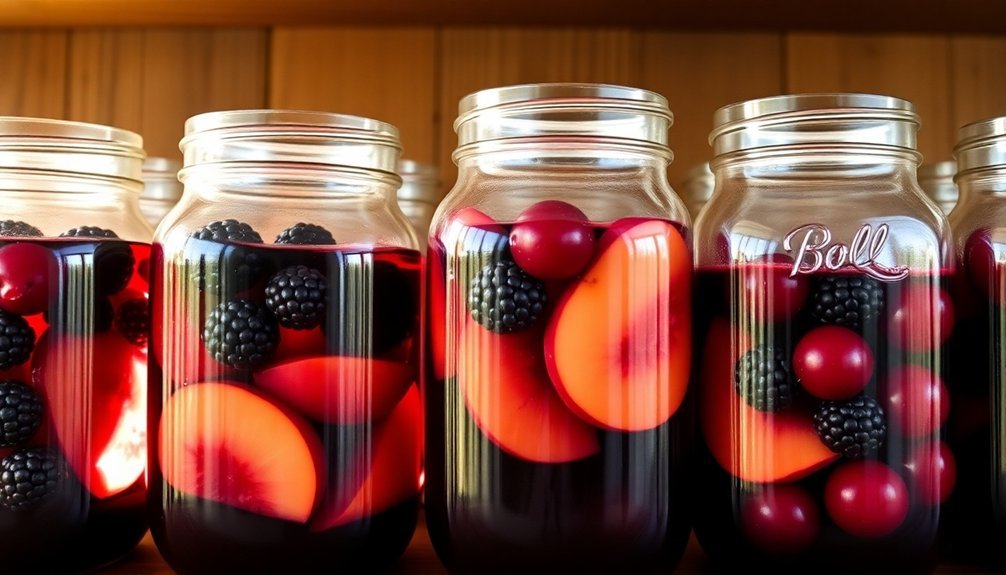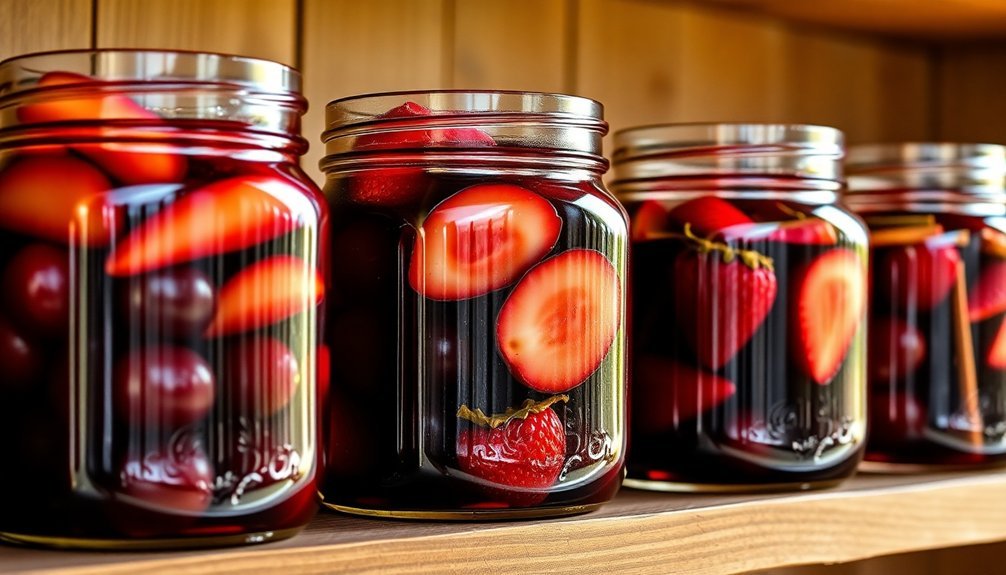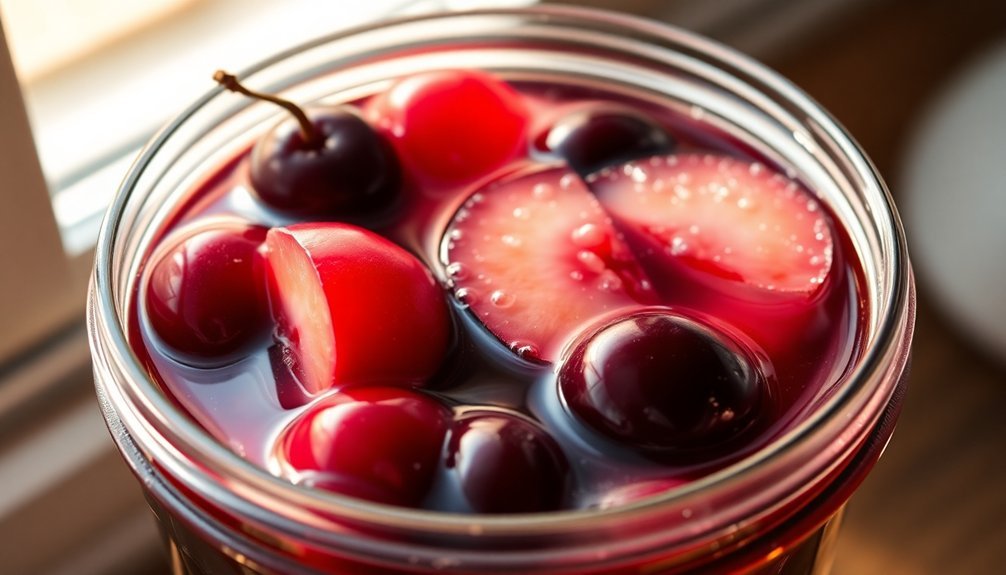To make delicious wine-soaked fruit, start by selecting perfectly ripe fruits like blackberries, plums, or peaches that show no signs of damage. Clean them thoroughly in a water-vinegar solution, remove stems and pits, then cut larger fruits into uniform pieces. Choose a wine that complements your fruit – bold reds work well with berries, while crisp whites pair nicely with peaches and apples. Place the prepared fruit in airtight mason jars, completely cover with wine, and store in a cool, dark place for at least a week. You'll be rewarded with flavorful preserved fruits that last up to three months when properly stored, and there's so much more to discover about perfecting this traditional preservation method.
Best Fruits for Wine Preservation

Wine enthusiasts seeking to explore fruit preservation have numerous options at their disposal.
If you're looking to create bold, full-bodied wines, blackberries and plums are excellent choices. Blackberries will yield a rich red wine that reaches its peak after two years of aging, while plums produce a characterful wine that's ready to drink after just one year. Apples make an exceptional blending base, making them perfect for creating unique flavor combinations.
For white wine lovers, peaches offer a full-bodied option with outstanding aroma, though you'll need to prepare for a somewhat messy process. Pineapples and persimmons are also viable choices, with persimmons requiring about 15 pounds per batch for ideal results.
When it comes to blending and enhancement, you'll find raspberries particularly versatile. They not only make excellent wine on their own but also improve the color and aroma of other fruit wines.
Consider combining pears with raspberries, as pears alone can taste rather flat. Grapes provide a reliable base with their fast, clean fermentation process, while gooseberries and boysenberries work well in various blends.
If you're working with gooseberries, aim for 11 pounds per batch to achieve the best results.
Selecting Your Perfect Wine
For wine-soaked fruit, you'll want to reach for bold red wines that can impart rich flavors and deep color to your fruits, with varieties like Cabernet Sauvignon and Merlot being excellent choices.
You don't need to spend much on expensive wines since the fruit-soaking process works equally well with budget-friendly options in the $10-15 range.
When selecting your wine, consider matching its natural flavor profile to your chosen fruits – for example, a jammy Zinfandel pairs wonderfully with berries, while a cherry-noted Pinot Noir complements stone fruits. Adding honey and brown sugar can enhance the overall sweetness and flavor complexity of your wine-soaked fruits.
Bold Reds Work Best
When selecting wine for soaking fruit, bold red varieties deliver the most impressive results thanks to their robust flavor profiles and structural components.
You'll want to focus on wines with higher alcohol content, typically 14.5% or above, as they're better at extracting fruit flavors and preserving your soaked fruit.
Look for full-bodied California Cabernets, Spanish Tempranillos from Ribera del Duero, or robust Rhône Valley reds like Châteauneuf-du-Pape. These wines offer the perfect combination of tannins, fruit intensity, and oak integration that'll enhance your fruit-soaking experience. Their authority and structure make them ideal candidates for fruit preservation.
South American options, including Chilean Carmenère or Malbec blends, also work exceptionally well.
When shopping, you'll find excellent choices from producers like Caymus and Lewis in California, or explore offerings from Spain's Priorat region.
The key is selecting wines with pronounced black fruit flavors and well-integrated oak tones. These characteristics come from expert barrel aging and skilled winemaking techniques, ensuring your wine-soaked fruit will absorb complex, layered flavors.
The combination of high alcohol content and rich tannins will help preserve the fruit while infusing it with deep, memorable flavors.
Affordable Options Enhance Results
While premium wines can deliver excellent results, many affordable options provide equally impressive outcomes for fruit soaking. You'll find excellent choices under $20 that bring unique character to your fruit-soaking endeavors.
For white wine-soaked fruits, consider the vibrant Domaine Vinet Muscadet Sevre & Maine at under $13, or try the invigorating Chateau Font-Mars Picpoul de Pinet at $12. These wines offer bright, crisp profiles that complement lighter fruits like peaches and apples.
The Charles Smith 'Eve' Chardonnay, also $12, provides a tangy foundation that works especially well with pears and tropical fruits.
For red wine infusions, look to the peppery Poco a Poco Russian River Zinfandel ($18) or the herbal Produttori del Barbaresco Langhe Nebbiolo ($20). These affordable reds deliver complex flavors that enhance darker fruits like plums and berries.
If you're experimenting with sparkling wine-soaked fruit, Martin Soler Rosé Brut Cava ($16) or Antech Emotion Crémant de Limoux ($15) offer excellent alternatives to pricier Champagne. Their bubbles and balanced profiles create intriguing textures in your fruit preparations.
Pair Wine With Fruit
Selecting the perfect wine to pair with fruit comes down to understanding the delicate balance between body, acidity, and flavor profiles. You'll want to match the wine's characteristics with your chosen fruit's intensity and sweetness level. For instance, pair full-bodied Cabernet Sauvignon with robust blackberries, while lighter fruits like melon work beautifully with crisp Vermentino.
Reflect on your fruit's acidity and sweetness when choosing your wine. High-acid wines like Riesling balance naturally sweet fruits such as peaches, while sweet Moscato enhances tropical fruits' natural sugars.
| Wine Type | Fruit Pairing | Key Characteristics |
|---|---|---|
| Cabernet Sauvignon | Blackberries | Full-bodied, tannic |
| Riesling | Peaches, Pineapple | High acidity, fruity |
| Moscato | Apricots | Sweet, floral |
| Pinot Grigio | Apples, Melon | Crisp, invigorating |
| Champagne | Strawberries | Effervescent, bright |
Don't forget to reflect on texture and ripeness. Crisp fruits like green apples pair wonderfully with acidic wines like Chardonnay, while ripe peaches complement the smooth texture of Chenin Blanc. For tropical fruits, reach for equally vibrant wines like Viognier or Albariño.
Essential Equipment and Tools

To create delicious wine-soaked fruit, you'll need specific equipment for each stage of the fermentation and bottling process.
Start with a primary fermentation container that's at least 40% larger than your intended wine volume, along with a nylon straining bag to hold your fruit. You'll also need an airlock with stopper and sanitizing solution to maintain everything clean.
For secondary fermentation, you'll want a glass carboy with a narrow neck, fitted with its own stopper and airlock.
Don't forget your hydrometer and test jar to monitor fermentation progress, plus a thermometer for temperature control. A bottling bucket will help with smooth transfers.
When you're ready to bottle, gather wine bottles, corks, a corker, and a bottling wand.
You'll need a bottle rinser to guarantee cleanliness, and a sanitized storage area for your finished products.
For quality control, consider investing in a pH meter or strips to monitor acidity, and a sulfite measuring system.
If you're working with whole fruits, a fruit crusher or food chopper will make preparation easier.
For precise measurements, keep a scale and pipettes on hand.
Preparing The Fruit
Select fresh, ripe fruits of uniform size and ripeness, guaranteeing they're free from blemishes and suitable for wine soaking.
You'll need to wash your chosen fruits thoroughly under cool water, removing any stems, leaves, or damaged portions while being careful not to bruise them.
Control the size of your fruits by cutting larger pieces into consistent portions, which will help guarantee even wine absorption and proper seasoning throughout the soaking process.
Proper Fruit Selection Process
Proper fruit selection stands as the foundation for creating exceptional wine-soaked fruit. You'll need to choose fruits that are perfectly ripe but not overripe to guarantee you're getting the best possible flavor and texture.
Consider both the seasonality of your fruits and their natural sugar-to-acid balance, as these factors will greatly impact your final product.
When selecting fruits for your wine-soaking adventure, you'll want to match them with your desired outcome. Berries typically create lighter, more delicate flavors, while harder-skinned fruits produce more robust results.
Always avoid using any fruits showing signs of rot or underripeness, as they can compromise your entire batch.
Here's what to look for when selecting fruits:
- Firm texture with slight give when gently pressed
- Vibrant, appropriate color for the fruit variety
- Fresh, clean aroma without any musty or fermented smells
- Unblemished skin without cuts, bruises, or soft spots
- Consistent ripeness throughout your selected batch
Remember that seasonal fruits at their peak will give you the best results, so plan your wine-soaking projects around local harvest times whenever possible.
Wash and Clean Carefully
Washing and cleaning your fruit stands out as an essential step in creating wine-soaked delicacies.
You'll need to start by preparing a water-vinegar solution, mixing 3 parts water with 1 part vinegar. Soak your fruit in this mixture for 15 minutes to remove dirt, bugs, and other contaminants.
Once soaked, remove all stems, twigs, and leaves from your fruit. Use a vegetable brush to scrub off stubborn dirt, especially on fuzzy fruits like peaches. Rinse thoroughly with clean water to remove any vinegar residue.
Don't use soap or detergents, as they'll leave unwanted flavors and are difficult to remove completely.
For extra sanitization, you can use a weak bleach solution (1 tablespoon per gallon of water) or Camden tablets if you're planning to ferment the fruit. Be sure to rinse thoroughly afterward.
Let your cleaned fruit dry on paper towels in a single layer, or pat them dry gently.
Store your cleaned fruit in airtight containers with paper towels between layers to maintain freshness. Make sure your storage containers are clean and sanitized to prevent contamination that could affect your wine-soaking process.
Season and Size Control
Throughout the seasons, careful fruit selection and sizing plays a crucial role in wine soaking. You'll want to choose fruits that are in season for the best flavor and availability. For ideal results, select fruits that maintain their texture and flavor during the soaking process, such as cranberries, raisins, and dried apricots.
When working with delicate fruits like blackberries, you'll need to adjust your soaking times accordingly.
Your preparation should focus on achieving uniform sizes to guarantee even soaking and consistent results. Here's what you'll need to do:
- Remove all seeds and pits to prevent unwanted bitterness
- Chop larger fruits into similar-sized pieces
- Halve oversized raisins for better liquid absorption
- Consider using muslin bags if keeping fruits whole
- Mash or puree fruits when you want intense flavor release
Remember to measure your fruit quantities precisely to maintain the right balance with your soaking liquid. You'll need enough liquid to fully immerse the fruit, so adjust accordingly based on your batch size.
For storage, use airtight glass jars and monitor the fruit's condition regularly, adding more liquid as needed to keep the fruits properly soaked.
The Soaking Process

The delicate art of soaking fruit in wine requires careful attention to detail and precise timing.
Start by rinsing your fruit thoroughly and removing any stems, unripe portions, or damaged areas. You'll need to crush the fruit to release its juices – use a rolling pin for soft berries or a food chopper for harder fruits.
Transfer your crushed fruit into a clean, airtight glass container and pour enough wine to completely submerge the fruit. Seal the container tightly and give it a good shake to guarantee even distribution.
You'll want to repeat this shaking process every few days throughout the soaking period.
The duration of your soak depends on your desired flavor intensity. You can soak for as little as an hour for quick consumption, or extend it up to several months for deeper flavors.
If you're planning a longer soak, you'll need to monitor the wine level and add more as the fruit absorbs it.
When you're ready to serve, pat the fruit dry and optionally coat it with sugar. You can enjoy it immediately or incorporate it into various desserts – just don't let it sit too long after removing it from the wine.
Spices and Flavor Combinations
Selecting the right spices and flavor combinations can transform ordinary wine-soaked fruit into an extraordinary culinary experience.
You'll find that herbs and spices work differently across seasons, with warming spices like cinnamon complementing winter fruits, while lighter herbs like basil and lavender enhance summer offerings.
When you're planning your wine-soaked fruit combinations, consider these essential pairings:
- Pair citrus fruits with rosemary and black pepper for a bright, aromatic blend
- Combine stone fruits with basil and white wine for a revitalizing summer treat
- Mix apples and pears with cinnamon and vanilla for a classic autumn flavor
- Blend figs and plums with port wine and black pepper for rich depth
- Match berries with lavender for a delicate, floral sweetness
You'll need to balance flavors carefully when combining fruits and spices.
If you're working with highly acidic fruits like lemons or sour cherries, add sweeter elements to create harmony.
Don't forget that some fruits, like blackcurrants, already contain natural tannins, so you won't need additional astringent elements in your recipe.
Remember to maintain consistency by using a single type of yeast when blending different wines.
Storage Methods That Work

Proper storage guarantees your wine-soaked fruit maintains its flavor, texture, and safety for consumption.
You'll want to start by placing your fruit mixture in airtight mason jars, ensuring the fruit stays completely submerged in the wine or alcohol mixture to prevent spoilage.
Store your jars in a cool, dark place for at least a week, allowing the flavors to meld properly. During this initial period, shake or stir the containers periodically to distribute the flavors evenly throughout the mixture.
After the first week, transfer the jars to your refrigerator to slow down the fermentation process and extend shelf life.
For ideal preservation, you can explore different storage methods. If you've used alcohol as your base, you'll get the best results by storing the mixture for 3-4 weeks in a dark cupboard before refrigerating.
Don't forget to add sugar according to your taste preferences. If you're planning for long-term storage, consider freezing the cooking liquor to create a granita, though be aware that freezing may affect the fruit's texture.
Remember to check your stored fruit regularly for any signs of spoilage or mold, and use within three months for the best flavor experience.
Serving Your Wine-Soaked Fruits
Every perfectly soaked wine fruit deserves an equally impressive presentation that highlights its complex flavors and elegant appearance.
You'll want to serve your wine-soaked fruits chilled for the best taste experience, either straight from the refrigerator or after letting them warm slightly at room temperature.
For an elegant presentation that'll wow your guests, contemplate these serving suggestions:
- Arrange fruits on decorative skewers for easy handling and a sophisticated touch
- Dust the fruits with a light coating of sugar to create a dessert-like experience
- Present fruits on a beautiful serving platter with complementary garnishes
- Use the leftover infused wine as a sauce or transform it into a granita
- Pair fruits with their original soaking wine for a cohesive tasting experience
Whether you're serving these fruits as an appetizer or dessert, you'll need to reflect on the wine and fruit pairing carefully.
Light fruits soaked in prosecco or white wine work beautifully as starters, while darker fruits infused with merlot or port make stunning desserts.
Remember that temperature plays a vital role in bringing out the complex flavors you've developed during the soaking process.
Recipe Variations and Adaptations

Creativity flourishes when adapting wine-soaked fruit recipes to your personal taste and available ingredients. You can substitute white wine for red wine to create a lighter flavor profile, and you're not limited to expensive wines – Merlot, Pinot Noir, or Zinfandel work perfectly well.
If you'd prefer a non-alcoholic version, try poaching fruits in saffron-infused water instead.
You'll find endless possibilities when experimenting with spices and flavorings. While cinnamon sticks, whole cloves, and star anise are classic choices, you can incorporate orange peel, vanilla beans, or even black peppercorns.
Add berries like raspberries or blackberries to enhance both flavor and color.
Don't feel restricted to traditional fruit choices either. While Bosc pears are popular for their firm texture, you can try preserving greengage plums in brandy or soaking cherries in red wine syrup.
Remember that fruits can be prepared whole or halved, depending on your preference and time constraints.
For storage flexibility, you can keep alcohol-preserved fruits in a dark cupboard for 3-4 weeks, then refrigerate them for up to three months.
If you're using a wine syrup base, your creations will last about a week in the refrigerator or six months in the freezer.
Frequently Asked Questions
Can Wine-Soaked Fruits Be Used in Baking Recipes?
Yes, you'll find wine-soaked fruits work perfectly in baking recipes. You can add them to fruit cakes, wine cakes, and sweet treats. They'll add rich flavor and moisture to your baked goods.
How Long Do Wine-Soaked Fruits Remain Safe to Eat?
When properly stored in a cool, dark place, you'll find your wine-soaked fruits stay safe for up to one year. Just make certain they're fully submerged in alcohol and keep them in airtight glass containers.
Can Non-Alcoholic Wine Substitutes Be Used for Soaking Fruits?
Yes, you can use non-alcoholic alternatives like grape juice, malt drinks, or orange juice with honey to soak fruits. They'll plump up your dried fruits effectively and provide rich flavors for your baking needs.
Will Wine-Soaked Fruits Stain Teeth or Clothing?
Yes, wine-soaked fruits will stain both your teeth and clothing. You'll need to rinse your mouth with water and brush promptly after eating, and you should protect your clothes with an apron while handling them.
Can Leftover Soaking Liquid Be Repurposed for Other Dishes?
You can definitely repurpose the soaking liquid! Use it as a marinade for meats, reduce it for flavorful sauces, incorporate it into jams and syrups, or even transform it into homemade vinegar.
In Summary
You'll find endless ways to enjoy your homemade wine-soaked fruits throughout the year. Whether you're serving them over ice cream, adding them to cocktails, or enjoying them on their own, these boozy treats bring sophistication to any occasion. Don't be afraid to experiment with different wine and fruit combinations – you might discover your new favorite preserved treat. Just remember to store them properly and savor responsibly.





Leave a Reply